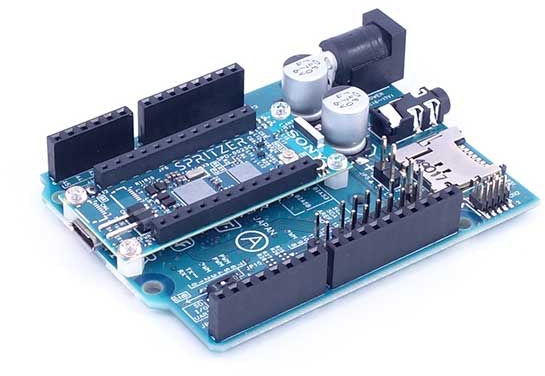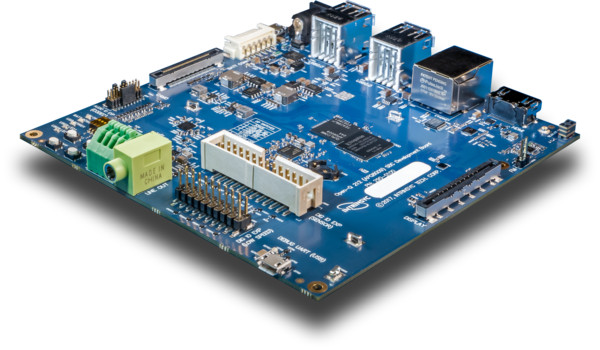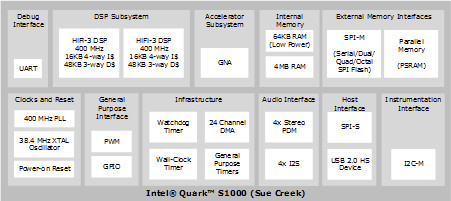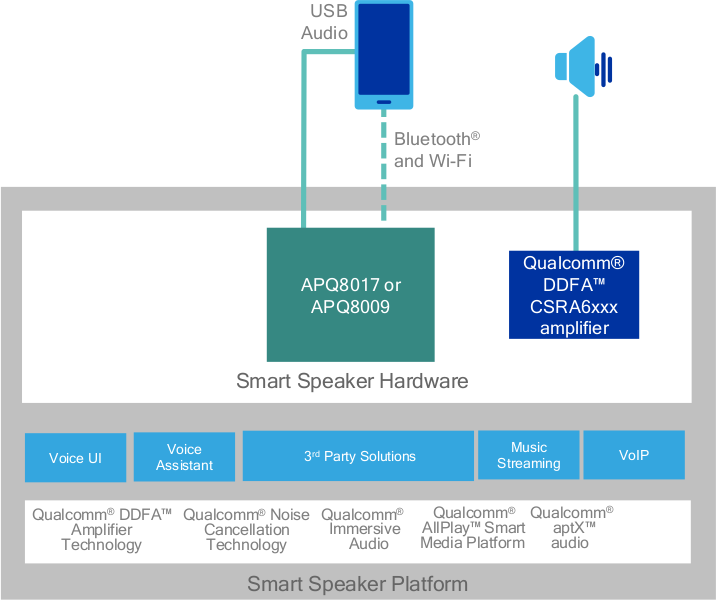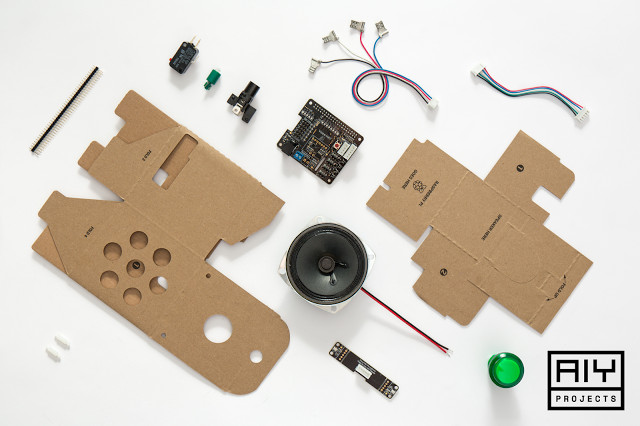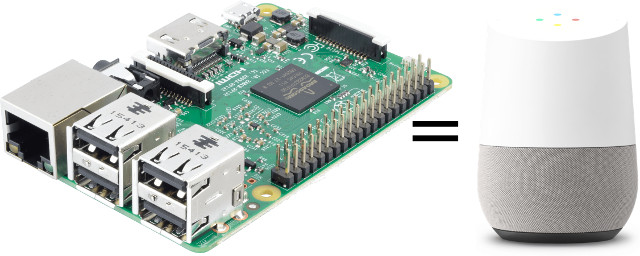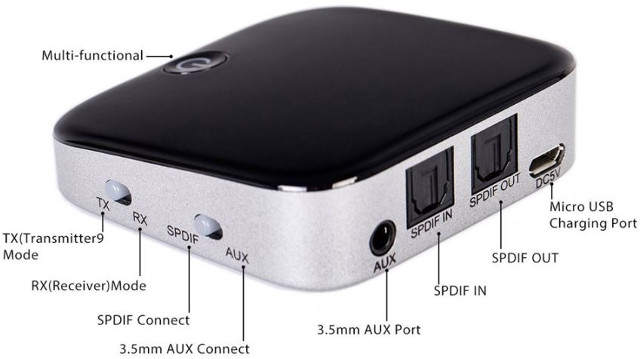Look who is joining the maker community! Sony has showcased their Arduino compatible Spritzer board during the Maker Faire Tokyo on August 5-6. Despite lacking on-board network connectivity, the board is said to have been designed for IoT applications with features such as an integrated GPS and an advanced digital audio codec and amplifier. Sony Spritzer specifications: MCU – Sony CDX5602 ARM Cortex-M4F ×6 micro-controller clocked at up to 156 MHz with 1.5MB SRAM Storage – 8MB Flash Memory, micro SD card GNSS – GPS, GLONASS, supported Audio – 3.5mm audio jack Expansion I/Os Digital I/O Pins – SPI, I2C, UART, PWM ×4 (3.3V) Analog Pins – 6ch (3.3V range) Audio I/O – 8ch Digital MICs or 4ch Analog MICs, Stereo Speaker, I2S, CXD5247 audio codec with 192 kHz/24bit High-Resolution audio 2x camera interfaces USB – 1x micro USB port for programming Power Supply – Via Power barrel and Vin […]
Qualcomm Snapdragon 212 Boards – Intrinsyc Open-Q 212 and Kaynes Technology SKATE-212
Qualcomm Snapdragon 212 (APQ8009) quad core Cortex A7 processor is used in entry-level smartphones, but it’s also one of the processors which the company expects to use in their Smart Speaker Platform leveraging Google Assistant, Amazon Alexa, and other A.I. voice services. Two company has designed single board computers that can be used for this purpose: Intrisync Open-Q 212 and Kaynes Technology SKATE-212. Intrisync Open-Q 212 SBC Development Board Contrary to some other Open-Q boards, but not all, Open-Q 212 is not comprised of a baseboard and a system-on-module, as everything is soldered on a single PCB. Open-Q 212 specifications: SoC – Qualcomm Snapdragon 212 (APQ8009) quad core ARM Cortex A7 processor @ 1.267GHz with Adreno 304 GPU, QDSP6 DSP System Memory – 1GB LPDDR3 Storage – 8GB eMMC (non-POP) flash and micro SD card socket Connectivity – Ethernet, pre-scanned Wi-Fi 802.11n 2.4Ghz (WCN3610) with chip and U.FL antennas, Bluetooth 4.1 […]
Intel Quark S1000 “Sue Creek” Processor to Support On-Chip Speech Recognition
Intel may have announced plans to discontinue several of their IoT boards, but based on some documents I received, the company has not given up on the Quark family, although they may have given up on the Intel architecture for low power microprocessor, as Intel Quark S1000 – codenamed “Sue Creek” – will feature two Tensilica LX6 cores (yes, just like ESP32), and is designed to handle speech recognition at the edge (e.g. locally), so some of your voice commands should still work when Internet is down. Intel Quark S1000 key features and specifications: Digital Signal Processors Dual Tensilica LX6 cores @ 400 MHz with HiFi3 DSP Single precision scalar floating-point instructions 16KB 4-way I$; 48KB 4-way D$ Up to 2400 DMIPS, 3.2 GMACS (16×16), 800 MFLOPS of Compute Speech Accelerators A GMM (Gaussian Mixture Model) and neural network accelerator Low power keyboard and limited vocabulary recognition Up to 9.6 […]
Qualcomm Announces Audio Platforms for Smart Speakers, Headphones, and Hearables
Smart speakers are getting a lot of buzz recently with products like Amazon Echo or Google Home, and many home automation products are advertised with Amazon’s Alexa support, so that they can be controlled by voice commands. Qualcomm is now going after this market, and others audio markets via 5 new platforms for streaming audio, high resolution audio, wireless audio, USB -C audio devices – due to the “death” of the 3.5mm headphone jack -, and hearables. The five platforms include: Bluetooth and BLE Audio SoCs such as Qualcomm CSRA68100 for premium wireless speakers and headphones. The SoC comes with flash, DSP, a 2-ch audio CODEC, USB & I/Os interfaces. Qualcomm QCC3xxx entry-level Bluetooth audio SoC for mid to low-cost Bluetooth headsets and speakers. Qualcomm WHS9420 (192kHz/24-bit audio) and WHS9410 (entry-level) USB-C audio SoC for USB-C headphones Qualcomm DDFA Digital Amplifier Technology with CSRA6xxx amplifier Smart Speaker Platform shown above […]
AIY Projects Voice Kit Transforms Raspberry Pi 3 Into Google Home, Comes Free with Raspberry Pi Magazine
We’ve just reported about the preview release of Google Assistant SDK that works on the Raspberry Pi 3, and other boards with a microphone, speakers, and access to Internet. The Raspberry Pi foundation and Google have now made it even easier, as they launched AIY Projects Voice Kit with a Google Voice HAT, a speaker, a stereo microphone Voice HAT board, a button, a few cables, and a cardboard case. You’ll just need to add your own Raspberry Pi 3, follow the instructions to assemble kits, load and setup the software. Once this is all done, you’ll be able to press the top button, asking anything you want to Google Voice, including the weather. Price? Sort of free, as it comes with MagPi 57 magazine, where you’ll also find detailed instructions for the kit. Google AIY Projects got its name from a mix between (DIY) and artificial intelligence (AI), and […]
Google Assistant SDK Turns Your Raspberry Pi 3 into Google Home
Google Home allows you to select music, control your home automation system and more with voice commands, but now you can do the same with a Raspberry Pi 3 as Google released a developer preview (alpha v1) of the Google Assistant API that works on Raspberry Pi 3, and other development boards running Debian or Ubuntu. Functionalities are limited right now, with RPC API and Python sample code, but it only works with English language, and features such as timers & alarm, playing music, news, or podcasts, and precise location are not supported. Location is determined using your IP address only, and if you’re using some third party services / products such as Uber or Hue, you’ll need an actual Google Home device for initial setup. Google has provided instructions to use Google Assistant SDK with Raspberry Pi 3 board. First you’ll need a USB microphone ($5.99 on Amazon), and […]
Google Releases Android O Developer Preview with UI & Audio Improvements, Better Performance, etc…
Nearly exactly one year after Android N developer preview release, Google has now announced the release of Android O developer preview in order to get feedback from the developer community before the official release of Android 8.0? Oreo? in Q3 2017. So what’s new so far in Android O? Here are some of the changes: Background activity limits – Automatic limits on what apps can do in the background for implicit broadcasts, background services, and location updates. Notification channels – New app-defined categories for notification content for better control from the use, as user may only block or change the behavior from one channel, instead of applying the same behavior to all notifications from a given app. For example, a News app may have notifications for Technology, Sports, Politics, International, etc… Autofill APIs – Platform support for autofill, where users can select an autofill app, similar to the way they […]
$32 Bluetooth 4.1 Audio Transmitter and Receiver Comes with S/PDIF Ports, a 3.5mm Audio Jack
As I browsed through DealExtreme new arrivals, I found a type of device I had not noticed in the past: a Bluetooth Audio transmitter and receiver that come with optical SPDIF input and output, as well as 3.5mm AUX port, and sells for $31.99 shipped on DX. Let’s have a look at the hardware first Audio In & Out – 3.5mm AUX port, SPDIF IN, SPDIF OUT Buttons – Tx/Rx mode selection, SPDIF/AUX selection, multifunction button Connectivity – Bluetooth 4.1 with 10 meters range; use aptX low latency audio Power Supply – 5V via micro USB port Battery – 350mAh rechargeable battery good for 15 hours on a charge; Charging time: 2 hours Dimensions – 6 cm x 6 cm x 1.84 cm The little device ships with a micro USB Cable for charging, a 3.5mm AUX cable, an optical TOSLINK cable, an RCA Cable, and a user manual. TX […]


